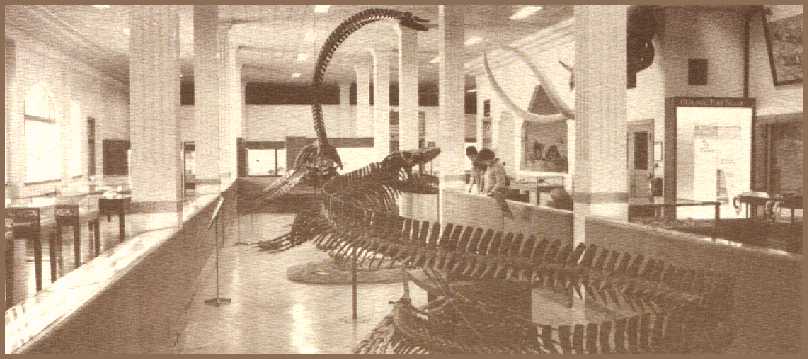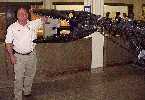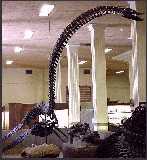
Mosasaurs from the Museum of Geology
South Dakota School of Mines and Technology
Copyright © 2000-2008 by Mike Everhart
 |
Mosasaurs from the Museum of Geology South Dakota School of Mines and Technology Copyright © 2000-2008 by Mike Everhart Last updated 03/14/08 |
The Museum of Geology at the South Dakota School of Mines has an outstanding mount of a 29 foot long mosasaur originally identified as Mosasaurus conodon (shown above). Like just about all mosasaur mounts, it is extremely difficult to capture the specimen in one photograph without losing much of the detail. The museum store does sell a very well done poster featuring this specimen. This specimen (SDSMT 452) is was found in the Pierre Shale (Campanian) near the spillway of Elm Lake, Brown County, South Dakota. It was cited and extensively figured in Dale Russell's 1967 benchmark publication (Systematics and Morphology of American Mosasaurs), and is the subject of a new paper currently in preparation.
The museum also houses many other vertebrate and invertebrate fossil specimens, as well as an extensive mineral collection. The collection includes other mosasaur material, the type specimen of the elasmosaur, Alzadasaurus pembertoni (now Styxosaurus snowii, see Carpenter, 1999), several dinosaurs, and Pleistocene mammals. It's open year-around (except holidays), and is certainly worth a visit if you are in the Black Hills area of South Dakota. Admission is free.
The museum also offers several field paleontology courses for credit during the Spring and Summer months. For more information, you can call 1-800-544-8162, ext. 2467, or write: Museum of Geology, 501 E. Saint Joseph St., Rapid City, SD, 57701. Their email address is: museum@sdsmt.edu.
This web page will, of course, feature the mosasaur material on display as well as some pictures of mosasaur specimens not seen by the public. So kick off your shoes and get ready to enjoy a virtual journey into the late Cretaceous seas that once covered South Dakota, and the rest of the Midwest.
 |
The right side of the skull of a mosasaur (SDSMT 452) identified as Mosasaurus conodon at the Museum of Geology. This skull is about 4 feet long, from the nose to the back of the lower jaw. If you are interested in the names of the bones of a mosasaur skull, particularly the lower jaw, CLICK HERE. |
 |
The left side of the same skull. Mosasaurus conodon is closely related to the first mosasaur ever found: Mosasaurus hoffmanni. It is also the only kind of a mosasaur that I have ever found in the Pierre Shale. |
 |
Possibly the last thing that many of this mosasaur's prey ever saw. This view inside the skull shows the two rows of pterygoid teeth at the back of the mouth. These served to help hold the prey while the mosasaur was swallowing it.... a very useful adaptation to living in the ocean, and for modern snakes. For a close up of the pterygoid teeth, CLICK HERE. |
 |
This picture shows the back of the right side of the skull. The distinctive quadrate bone, which serves as the hinge point for the lower jaw and supports the ear drum is in the center of the picture. For a labeled version of this picture, CLICK HERE. |
 |
 |
A series of upper right side skull photographs added 9/23/00 |  |
 |
 |
An overview of the skeleton of Mosasaurus conodon. While swimming the front and rear limbs would have been held against the body except when needed for steering. |
 |
The right front limb (paddle) of SDSMT 452 showing the attachment to the shoulder. The limbs of Mosasaurus were very robust compared to those of earlier mosasaurs such as Tylosaurus. |
 |
A closer view of the right front paddle. Mosasaurus limb and paddle bones have very distinct shapes. For a picture with the limb bones labeled, CLICK HERE |
 |
The left rear limb (paddle) and tail of Mosasaurus conodon. For a picture with the limb bones labeled, CLICK HERE. The tail is about half the length of the body. |
 |
A look at the the back end of the same mosasaur. Mosasaurs swam using an undulating, side to side movement of their tail, much like that of a modern snake. |
 |
The author shown for the sake of scale as compared to a 29 foot long mosasaur. |
..........and what did mosasaurs eat?
 |
This plaster jacket (SDSMT 10439) contains the vertebrae, pelvic and limb bones of a large mosasaur (Tylosaurus) as well as the preserved remains of the animals (a fish, a bird and a smaller mosasaur) that the Tylosaur ate shortly before it died. To see this picture with the Tylosaurus bones labeled, CLICK HERE. To see a colored drawing that shows the stomach contents, CLICK HERE. (Copyright SDSMT © Museum of Geology) |
 |
This jumble of bones is the last remains (mostly vertebrae) of a mosasaur called Clidastes. The large bone in the center is part of the hips (the ileum) of the larger Tylosaurus. While the Tylosaurus was probably about 10 m in length, the Clidastes was probably less than 4 m in length. The stomach contents were part of a nearly complete Tylosaurus specimen found in the summer of 1978 in the Gammon Ferruginous Member of the Pierre Shale. |
 |
This close up shows several of the bones from the anterior end of the Clidastes, including a quadrate, a possible pterygoid bone and several cervical vertebrae. The interpretation is made that the Clidastes was swallowed head first. |
 |
This picture shows the bones of a large, flightless bird called Hesperornis found within the stomach contents. The birds swam in the Cretaceous seas much like modern penguins, probably feeding on smaller fish and squid. To see a picture of a Tylosaurus chasing a Hesperornis, CLICK HERE. |
| For more information about the above specimen, see: Martin, James E. and Bjork, Phillip R., 1987, Gastric Residues Associated with a Mosasaur from the Late Cretaceous (Campanian) Pierre Shale in South Dakota, Dakoterra, Vol. 3, pp. 68-72
|
|
 |
The skull of a Platecarpus (SDSMT 30139) from the Pierre Shale near Edgemont, South Dakota. Platecarpus was a very common mosasaur in the Niobrara chalk and early Pierre Shale. |
 |
The underside of a very complete and nearly three dimensional skull of Prognathodon overtoni (SDSMT 3393), from the Virgin Creek Member of the Pierre Shale, Shannon County, South Dakota. Prognathodon is a relatively rare mosasaur and may be related to Globidens. To go to the Prognathodon overtoni page, CLICK HERE (New 07/29/00) |
| .............and from the collections in storage
|
|
 |
The skull of a huge Prognathodon overtoni from the Pierre Shale called the "Dewey County Mosasaur". It was collected from an island in the Missouri River about 1990 by Jim Martin and Dan Varner. (There's a great story behind this one... ask Dan sometime). Note the scale at the top of the picture is 10 cm or about 4 inches. CLICK HERE for a different view. |
 |
A very scattered Clidastes propython specimen from the Niobrara chalk of South Dakota. The various bones are labeled in the larger picture (unnumbered, from the WHO collection). Scale is 10 cm. |
 |
A close-up view of the long, slender (and very toothy) lower jaws of Clidastes propython. |
 |
The underside of the frontal bone from the skull of Clidastes propython. This bone is found on the top of the skull, between the eyes of the mosasaur. |
 |
Most of another very large skull of a tylosaurine mosasaur (probably Hainosaurus) from the Sharon Springs Member of the Pierre Shale, south of Rapid City, S. D. In this jacket, from right to left, the premaxilla, nasals, frontal and part of the parietal are visible. Scale = 10 cm. |
 |
The quadrates of the above Hainosaurus. Like the skull, these bones are truly huge compared to those of most other mosasaurs. Scale = 10 cm (about 4 inches) |  |
 |
One of the large teeth found with this specimen. For two other views of the same tooth, CLICK HERE, and CLICK HERE. Scale is in cm. |
 |
One of the front limbs of a Plioplatecarpus (SDSMT 40597). These limb bones are much more robust than those of a typical tylosaur and suggests that some of the later mosasaurs were using their front limbs much more than the earlier mosasaurs for directional control or underwater 'flying'. |
 |
The top of the skull of another Plioplatecarpus (SDSMT 40596) from the Gregory Member of the Pierre Shale, Buffalo County, South Dakota. The various bones and other features are labeled in the larger version. |
 |
A small, unnumbered mosasaur skull from the Pierre Shale in the collection of the Museum of Geology. The scattered elements of this skull probably came from a juvenile Platecarpus. To see the elements of the skull labeled, CLICK HERE. |
This is only a small portion of the extensive collection of fossil specimens at the Museum of Geology.... the exhibits also include:
 |
............ a large plesiosaur (Styxosaurus snowii). Click here to go to the Museum of Geology Styxosaurus snowii page. (Updated 09/25/2000) |
 |
.... several marine turtle skulls (Toxochelys browni) |
 |
..... a large fish (Xiphactinus audax), about 12 feet long |
 |
.... a smaller fish, preserved in 3-D (probably Apsopelix anglicus), about 2 feet long |
 |
... a jaw plate from the shell crushing shark, Ptychodus mortoni. |
 |
... fossil crabs from Mississippi (Avetilmessus grapsoideus) |
 |
..... colonial crinoids (Uintacrinus socialis) from the Smoky Hill chalk of Kansas. See close-ups of several individuals from the Sternberg Museum: HERE, HERE and HERE. |
 |
... a section of a baculite (Baculites compressus) from the Pierre shale. Note the distinctive sutures. |
 |
... one of many ammonites (Prionocyclus wyomingensis) on display |
 |
.... another large ammonite (Collignoniceras woollgari) |
 |
... and last but not least, a couple of dinosaurs, including this Tyrannosaurus rex skull. |
Bell, G. L. Jr., J. E. Martin, D. C. Parris, and B. S. Grandstaff, 1994. Mosasaurus dekayi in the upper Cretaceous (Campanian-Maastrichtian) marine deposits of South Dakota and New Jersey. Jour. Vert. Paleon. 14(Supplement to 3):17A.
Bell, G. L. Jr., M. A. Sheldon, J. P. Lamb and J. E. Martin. 1996. The first direct evidence of live birth in Mosasauridae (Squamata): Exceptional preservation in Cretaceous Pierre Shale of South Dakota. Journ. Vert. Paleon. 16(supplement to 3):21A.
Bell, G. L. Jr., and J. P. VonLoh, 1998. New Records of Turonian Mosasauroids from the Western United States, Fossil Vertebrates of the Niobrara Formation in South Dakota, Dakoterra 5:15-28
Carpenter, K., 1999. Revision of North American Elasmosaurs from the Cretaceous of the Western Interior, Paludicola, 2(2):148-173.
Martin, J. E. and P. R. Bjork, 1987. Gastric Residues Associated
with a Mosasaur from the Late Cretaceous (Campanian) Pierre Shale in South Dakota,
Dakoterra, Vol. 3, pp. 68-72.
Martin, J. E. and Kihm, A. J., 1988. Two Unusual Stratigraphic Occurrences of Plesiosaurs
from Late Cretaceous Formations of the Black Hills Area, Wyoming and South Dakota, Proc.
S. D. Acad. Sci., Vol. 67, pp. 73-75
Martin, J. E. and Kennedy, L. E., 1988, A Plesiosaur from the Late Cretaceous (Campanian)
Pierre Shale of South Dakota: A Preliminary Report, Proc. S. D. Acad. Sci., Vol. 67, pp.
76-79
Martin, J. E. and J. D. Stewart, 1993. Late Cretaceous Selachians and associated marine
vertebrates from the Dakota Rose Quarry, Grant County, South Dakota. Proc. S. D. Acad.
Sci. 72:241-248.
Martin, J. E. 1994, A baby plesiosaur from the late Cretaceous Pierre Shale, Fall River
County, South Dakota. Jour. Vert. Paleon. 14(Supplement to 3):35-36A.
Martin, J. E. 1994. Gastric residues in marine reptiles from the late Cretaceous Pierre
Shale in South Dakota: Their bearing on extinction. Jour. Vert. Paleon. 14(Supplement to
3):36A.
Martin, J. E., B. A. Schumacher, D. C. Parris and B. S. Grandstaff, 1998. Fossil Vertebrates of the Niobrara Formation in South Dakota, Dakoterra 5:39-54
Russell, D. A. 1967, Systematics and Morphology of American Mosasaurs Peabody Museum of Natural History, Yale University, Bulletin 23.
Russell, D. A. 1975, A New Species of Globidens from South Dakota, Fieldiana Geology, Volume 33, No. 13, Field Museum of Natural History
Schumacher, B. A. and J. E. Martin, 1993, First Definitive Record of the Mosasaur Tylosaurus proriger from the Niobrara Formation (upper Cretaceous), South Dakota, Proc. S.D. Acad. Sci., Vol. 72, pp. 235-24
Schumacher, B. A. and D. W. Varner, 1996. Mosasaur caudal anatomy. Jour. Vert. Paleon. 16(supplement to 3):63ASheldon, M. A. , G. L Bell, Jr., and J. P. Lamb, 1996. Histological characters in prenatal specimens of the mosasaur, Plioplatecarpus primaevus. Jour. Vert. Paleon. 16(supplement to 3):64A.
VonLoh, J. P. and G. L. Bell Jr., 1998. Fossil Reptiles from the Late Cretaceous Greenhorn Formation (Late Cenomanian-Middle Turonian) of the Black Hills Region, South Dakota, Dakoterra Vol.5, pp. 28-38
Welles, S. P. and J. Bump, 1949. Alzadasaurus pembertoni, a new elasmosaur from the Upper Cretaceous of South Dakota, Jour. Paleon., 23(5): 521-535